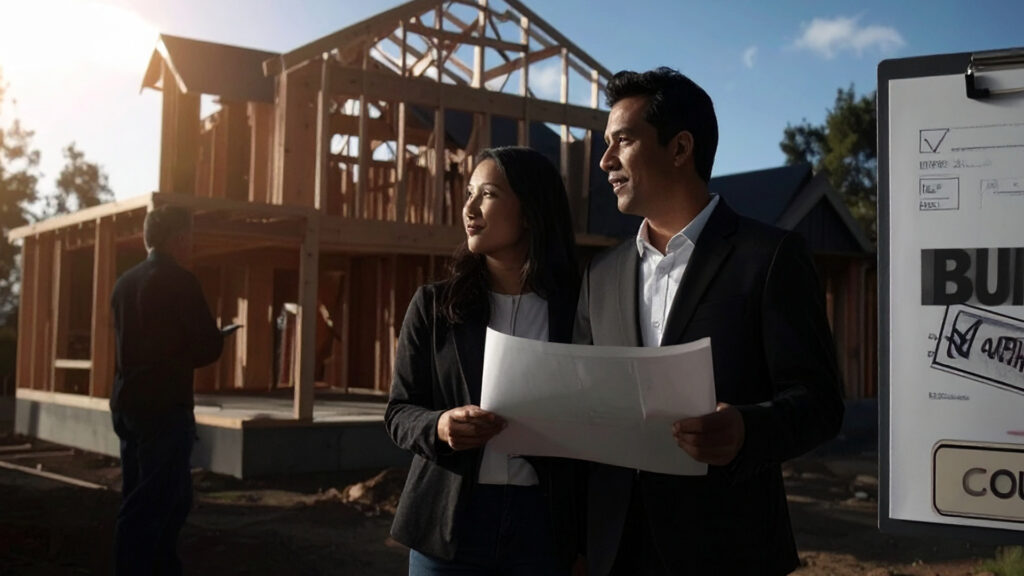Let’s paint a picture. You’re standing in your backyard, eyes tracing the line where a beautiful new deck will go. It’s going to be the heart of your summer – BBQs with friends, lazy Sunday mornings with a coffee, a safe place for the kids to play. Or maybe you’re in the kitchen, visualizing the wall coming down to create that glorious, light-filled, open-plan space you’ve been dreaming of for years.
The dream is vivid, exciting, and feels so close. But then, a two-word phrase creeps into your mind, often whispered like a mythical beast that guards the treasure you seek: Building Consent.
For many Kiwi homeowners, this is where the excitement can curdle into confusion and anxiety. It feels like a mountain of paperwork, confusing jargon, and bureaucratic red tape designed to slow you down.

But what if I told you it doesn’t have to be that way?
As someone deep in the world of property and construction, I’ve seen it all: the triumphant successes and the costly, heartbreaking setbacks. The difference almost always comes down to understanding the process. A building consent isn’t your enemy; it’s your project’s most important insurance policy. It’s the framework that ensures your beautiful dream deck doesn’t collapse during your housewarming party and that your new bedroom is a healthy, safe place to sleep.
This guide is for you. Let’s demystify the NZ building consent process, step by step, and turn that confusion into confidence.
First Things First: Do I Even Need a Building Consent?
This is the million-dollar question, and getting it wrong is the first, and often most expensive, pitfall. Not all work requires a building consent. The Building Act includes a list of “exempt building work” (under Schedule 1) that you can carry out without needing council approval.
But here’s where caution is your best friend. These exemptions are highly specific.
Think of it like this:
- Likely Exempt: Building a small garden shed (under 10 square metres and meeting specific placement rules), repairing a few rotten weatherboards, or building a low-level deck (less than 1.5 metres off the ground).
- Likely Needs Consent: Building a large sleepout (over 10 square metres), adding a new bathroom, removing a load-bearing wall, installing a fireplace, or re-cladding your entire house.
The golden rule is “When in doubt, check it out.” The rules can be nuanced. For example, a retaining wall under 1.5 metres might be exempt, but not if it’s supporting extra load like a driveway or the foundations of your house.
Your Action Plan:
- Visit the MBIE “Can I Build It?” Tool: The Ministry of Business, Innovation and Employment has an excellent online tool to guide you.
- Talk to a Professional: An architect, draughtsperson, or Licensed Building Practitioner (LBP) will know the Building Code inside and out.
- Call Your Local Council: They have duty planners who can provide free, preliminary advice. A 15-minute phone call can save you thousands of dollars and months of headaches. Getting this right is the foundation of your entire project.
Also Read: Construction Cost Volatility 2025: Geopolitics & Tariffs Impact
Your Step-by-Step Journey Through the Consent Maze
So, you’ve confirmed you need a consent. Don’t panic. Let’s break the journey down into manageable stages.
Stage 1: The Dream Team and The Master Plan
Before you even think about filling out a form, you need a detailed plan. This isn’t a sketch on the back of a napkin. This is the stage where you engage the professionals who will turn your vision into a buildable, compliant reality.
- Architect/Draughtsperson: They will create the detailed architectural drawings and specifications that form the core of your application. They are your translator, turning your ideas into the technical language the council and your builder understand.
- Engineer: If your project involves structural changes (like removing a load-bearing wall or building on tricky ground), you’ll likely need a structural engineer to provide designs and calculations.
- Licensed Building Practitioner (LBP): For any “Restricted Building Work” (work critical to a home’s structural integrity and weather-tightness), the design and construction must be carried out or supervised by an LBP.
Investing in a good team at this stage is the single best thing you can do for your project. High-quality, comprehensive plans make the entire process smoother, faster, and often cheaper in the long run.
Stage 2: The Application – Assembling Your Toolkit
Your designer will typically lead this stage. The application is a comprehensive package of documents that proves to the council that what you plan to build will meet the New Zealand Building Code. This usually includes:
- Completed application forms.
- Detailed architectural plans and specifications.
- Structural engineering reports (if required).
- A site plan showing the location of the proposed work.
- Evidence of ownership (a Record of Title).
Think of it as showing your work in a maths exam. You can’t just write down the answer; you have to prove how you got there.
Stage 3: Lodgement and “The 20-Day Clock”
Once your application is submitted to the council, a statutory clock starts ticking. The council has 20 working days to process your application and decide whether to grant the consent.
However, this clock can be paused…
Stage 4: The Inevitable RFI (Request for Further Information)
It is incredibly common for the council to pause the 20-day clock and send you an RFI. Do not see this as a failure. See it as a conversation. The council’s job is to ensure every detail is correct. An RFI simply means they need more clarity on a specific point. It could be a question about a particular material, a request for more detail on waterproofing, or clarification on a boundary line.
The key here is to respond promptly and thoroughly with the help of your designer. The clock remains paused until you provide all the requested information. This is where many delays happen, so a swift, complete response is crucial.
Stage 5: Consent Granted! Time to Build? Almost.
Congratulations! You have your approved building consent. This document is your permission to begin construction.
But it’s not the end of the council’s involvement. The consent will list a series of required inspections that must be carried out at key stages of the build (e.g., foundations, pre-line, post-cladding). It’s your responsibility to book these inspections with the council. Missing them can have serious consequences down the line.
Warning Signs: Common Pitfalls That Can Derail Your Project ⚠️
Learning from others’ mistakes is far cheaper than making your own. Here are the most common traps to avoid:
- Starting Work Before Consent is Issued: This is the cardinal sin. It can lead to a “Notice to Fix,” hefty fines, and the potential need to demolish the work you’ve already done.
- Underestimating the True Timeline: Don’t book your builder to start a week after you lodge your application. Factor in time for design, potential RFIs, and then the build itself. A realistic timeline prevents immense stress.
- Submitting Vague or Incomplete Plans: The “she’ll be right” approach doesn’t work here. Poor documentation is the number one cause of RFIs and delays. Invest in quality plans.
- Ignoring the Final Step: The Code Compliance Certificate (CCC): Once all work is finished and all inspections are passed, you must apply for your CCC. This is the council’s official declaration that the completed work meets the building consent. Without a CCC, you may have issues with insurance and will face major hurdles when you try to sell your property. It’s the final, vital piece of the puzzle.
The Real Value: Why Bother With All This?
After all this, you might be wondering if it’s worth it. The answer is a resounding YES.
Doing it by the book gives you:
- Safety & Peace of Mind: You know your home is strong, weathertight, and healthy for your family.
- Protecting Your Biggest Asset: Unconsented work can significantly devalue your home. A full set of approved plans and a CCC are gold when it comes time to sell.
- Insurability: Insurance companies can, and do, refuse to pay out for damage related to unconsented work.
- A Smoother Build: A clear, consented plan means your builder knows exactly what to do, leading to fewer disputes and variations on-site.
Navigating the NZ building consent process is a journey. It requires patience, a great team, and a willingness to do things correctly. But it is not an insurmountable mountain. By understanding the path and preparing for the key milestones, you can transform that initial anxiety into a feeling of control and empowerment.
You can make that dream deck or kitchen a reality, not just beautifully, but safely and smartly, protecting your family and your investment for years to come.
